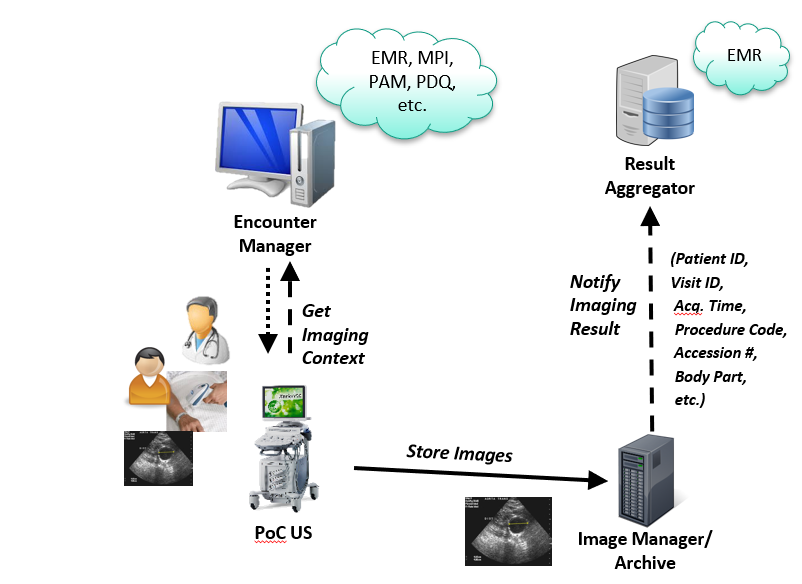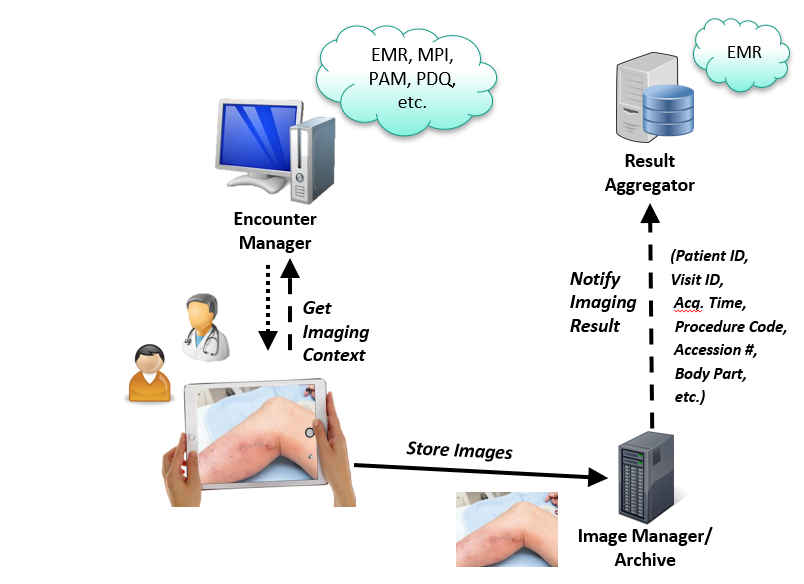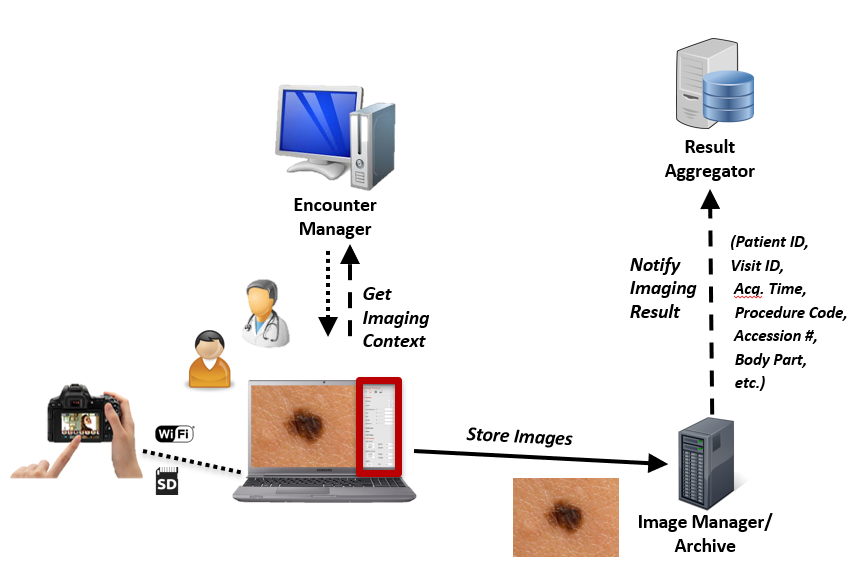Difference between revisions of "Encounter-Based Imaging Workflow"
| Line 6: | Line 6: | ||
Increasingly medical imaging is done outside the context of an ordered procedure. Such "encounter-based imaging" needs robust integration, data management and workflow for the same reasons order-based imaging needed the [[Scheduled Workflow]] Profile. | Increasingly medical imaging is done outside the context of an ordered procedure. Such "encounter-based imaging" needs robust integration, data management and workflow for the same reasons order-based imaging needed the [[Scheduled Workflow]] Profile. | ||
| − | + | Essentially, a patient ID or visit ID is used to query for full metadata (patient demographics, admission details, etc) which are applied to the image when stored, along with procedure details (anatomy, imaging procedure type, etc), making it possible to store, manage, find and use the images when needed. A notification to the EMR contains the details needed to index the images and link them to the medical record. | |
| − | [[Image: | + | [[Image:EBIW_Diagram_POCUS.png|500px]] |
| + | The same pattern applies to tablets, smartphones and digital cameras. As long as the metadata is assembled before sending the images to storage, it is flexible as to whether the query happens before or after the images are acquired, and whether the procedure metadata is collected on the device or on a separate screen. | ||
| − | + | [[Image:EBIW_Diagram_Tablet.png|500px]] | |
| − | + | [[Image:EBIW_Diagram_SLR.png|500px]] | |
| − | |||
| − | |||
==Benefits== | ==Benefits== | ||
Revision as of 20:33, 26 August 2019
Encounter-Based Imaging Workflow (EBIW) captures images acquired in the context of an encounter between a patient and a healthcare provider, links them with critical metadata, and notifies the EMR.
Summary
Increasingly medical imaging is done outside the context of an ordered procedure. Such "encounter-based imaging" needs robust integration, data management and workflow for the same reasons order-based imaging needed the Scheduled Workflow Profile.
Essentially, a patient ID or visit ID is used to query for full metadata (patient demographics, admission details, etc) which are applied to the image when stored, along with procedure details (anatomy, imaging procedure type, etc), making it possible to store, manage, find and use the images when needed. A notification to the EMR contains the details needed to index the images and link them to the medical record.
The same pattern applies to tablets, smartphones and digital cameras. As long as the metadata is assembled before sending the images to storage, it is flexible as to whether the query happens before or after the images are acquired, and whether the procedure metadata is collected on the device or on a separate screen.
Benefits
A new Encounter-Based Imaging Workflow Profile would specify how to integrate the devices to capture appropriate context, populate relevant indexing fields, link to related data, and ensure the images are accessible and well-knit into the medical record.
Experts from Duke, U Miami, Mayo, and Northwestern have already authored several whitepapers detailing this problem and considerations in solving it. It has been the subject of many conference sessions. These experts have agreed to participate in the profile development and contribute their institutional experience tackling this problem and encourage their vendors to participate.
IHE is a good venue to solve this because many proprietary ad-hoc workflows are emerging/exist but are inconsistent, incomplete and poorly integrated. The need is real. All that is missing is a profile to drive integrated, complete, consistent solutions. As with SWF, an IHE solution could avoid the costs and incompatibilities of the proprietary solutions.
Details
<A few paragraphs, if appropriate, providing more details (mostly in user-speak, not tech-speak) on what the profile does and how it works.>
<If the user might be familiar with the mechanisms used by the profile, you can mention them here. E.g. Evidence Documents is based on DICOM Structured Report (SR) Templates.>
<If the user might have an appreciation for the problems addressed in the profile, you can mention them here, but keep it short. E.g. Mapping HL7 Order fields to DICOM Modality Worklist attributes can be inconsistent in the marketplace, so Scheduled Workflow provides vendors with more detailed instructions.>
Systems Affected
<List (in user terms) the types of systems they might expect to have implemented actors from this profile, e.g. RIS, PACS, HIS, CAD Workstation, etc. and for each, how it would participate.>
- PACS systems may store, manage, and/or display Evidence Documents.
- Display systems may query, retrieve and display Evidence Documents.
- Reporting workstations may retrieve, process and include details from Evidence Documents in reports
Actors & Transactions:
<Insert an actor-transaction diagram, and or list of Content Definitions>
Specification
Profile Status: Trial Implementation
Documents:
IHE Radiology Technical Framework:
Underlying Standards:
See Also
Related Profiles
<List profiles this one depends on, profiles that depend on this one, profiles that are synergistic with this one. Start with the name of the other profile as a link and then explain the relationship.>
- Reporting Workflow [RWF] may use Evidence Documents as inputs to the reporting process.
- Simple Image & Numeric Reports [SINR] may include data copied from Evidence Documents.
- Cross-enterprise Document Sharing for Imaging [XDS-I] can be used to share Evidence Documents between sites over a network.
- Portable Data for Imaging [PDI] can store Evidence Documents on media such as CDs.
- Import Reconciliation Workflow [IRWF] can fix patient ids, etc. of Evidence Documents when importing.
Consumer Information
The Profile FAQ Template answers typical questions about what the Profile does. <Replace the link with a link to the actual FAQ page for the Profile>
The Profile Purchasing Template describes considerations when purchasing equipment to deploy this Profile. <Replace the link with a link to the actual Purchasing page for the Profile>
Implementer Information
The Profile Implementation Template provides additional information about implementing this Profile in software. <Replace the link with a link to the actual Implementation page for the Profile>
Reference Articles
<List References (good and bad) (with link if possible) to Journal Articles that mention IHE's work (and hopefully include some analysis). Go ahead, Google: IHE <Profile Name> abstract or Google: IHE <Profile Name> and under the "more" select "Scholar". You might be surprised. > This page is based on the Profile Overview Template


